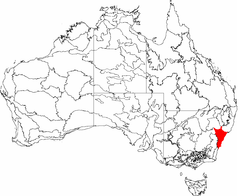Eora
The Eora people are a group of Aboriginal Australians. They were skilled hunter–fisher–gatherers. They lived in family groups (clans) along the coastal area of what is now known as the Sydney basin, in New South Wales, Australia. Their traditional territory spreads from Botany Bay north to Pittwater at the mouth of the Hawkesbury River.
Rock engravings, shell mounds and other evidence found by archaeologists suggests that Eora people may have lived in Australia for over 50 000 years.[1]
Many of the Eora people died during the 1800s as a result of smallpox and other diseases. There are still people who identify as the descendants of the Eora and are living in Sydney today.[2]
Language
The Eora people are made up of many clans (groups) including the Cadigal, the Wanegal, and the Cammeraygal.[3]
They spoke languages now known as Dharug, Dharawal and Kurringgai.[4] Several Eora words have found their way into Australian English, for example dingo, gibba and woomera.[5]
Lifestyle
The traditional Eora people lived along the coast of the Sydney region, surrounded by beaches, rivers, mountains and forests. Like most indigenous people, they were hunter-gatherers. They did not have a specific piece of land which they owned, but they moved and lived from place to place.
They mainly fed on fresh produce from the sea including fish, turtles and other seafood. There were also many animals they hunted for food, especially ducks, cockatoos and pigeons.[6] They were experts in close-to-shore navigation, fishing and making fire. They travelled along the coast and fished in bark canoes. The Eora people did not grow or plant crops - they ate the berries, seeds and fruit that the land provided. They never took more than what was needed from the land, and managed the land so they wouldn't waste its resources. The women picked herbs which were used in herbal remedies.
The Eora people camped nearby the water and slept in caves when it rained.[7] They kept close to rivers and waterways because it was their main source of food. When it got cold, blankets of animal fur were used for warmth. They also kept warm by keeping small fires going.
The Eora were very spiritual people. They believed that inside everything was a living spirit. They also believed that if land was taken away from them that all the spirits in that land would also die. Celebrations, rituals and ceremonies were an important part of life for the Eora peoples. Some initiation ceremonies were secret and only attended by males. As part of the boys’ initiation, knowledge and beliefs were passed on for their role as an adult. Boys went through a tooth ceremony in which their front tooth was knocked out. The missing tooth was a sign to others that the boy had been initiated. Girls learned cooking and knowledge of medicinal plants and roots, and how to track small animals.[8]
Arrival of the First Fleet
The Eora peoples are the traditional owners of the land that is now inner Sydney. They were present during the arrival of the First Fleet.
When the First Fleet arrived in January, 1788 transporting thousands of prisoners, the Eora peoples thought the ships had come to stop for supplies and water. Some of the Eora believed the ships were in fact spirits. They soon realised that the British had come to stay.
Governor Phillip wanted to establish friendly relationships with the Eora peoples and commanded the convicts and marines to treat them well. It wasn’t long before clashes broke out between the two groups. Both the Eora and the European settlers were responsible for attacks. People on both sides were killed.[9]
Fighting with European settlers, the introduction of new diseases like smallpox, and the destruction of their natural food sources saw about 90 per cent of the Eora people die out between 1788 and 1900.[10]
Many Eora peoples moved away from the Sydney region to escape from European settlers and the diseases that were spreading in the area such as smallpox. Some who stayed adopted European customs like wearing clothes, smoking pipes of tobacco and drinking alcohol. They gave up their traditional ways of life and depended on settlers to give them food. [8]
Notable people
Bennelong, a Wangal of the Eora peoples,[3] served as a link between the British colony at Sydney and the Eora people in the early days of the colony. He was given a brick hut on what became known as Bennelong Point where the Sydney Opera House now stands. He traveled to England in 1792 along with Yemmerrawanne and returned to Sydney in 1795. His wife, Barangaroo, was an important Cammeraygal woman from Sydney's early history who was a powerful and colourful figure in the colonisation of Australia. She is commemorated in the naming of the suburb of Barangaroo, in east Darling Harbour.
Eora Media
References
- ↑ "Introduction to Aboriginal Sydney". Australian Museum. 2013.
- ↑ "Eora - Mapping Aboriginal Sydney".
- ↑ 3.0 3.1 http://www2.sl.nsw.gov.au/archive/events/exhibitions/2006/eora/docs/eora-guide.pdf
- ↑ "Aboriginal people and place". BaraniBarani.
- ↑ "Human Society & Its Environment K-6 Stage 2 Units" (PDF). Archived from the original (PDF) on 2013-05-17.
- ↑ "The First Australians — Scots and Australia". 2013. Archived from the original on 2016-07-03.
- ↑ "Observatory Hill EEC — NSW Department of Education and Communities" (PDF).[dead link]
- ↑ 8.0 8.1 "Before Time | My Place for teachers". 2013.
- ↑ "E4AC | Y4 | S7 Sample assessment text". 2013. Archived from the original on 2016-06-25. Retrieved 2016-07-08.
- ↑ "Before Time | My Place for teachers". 2013.


